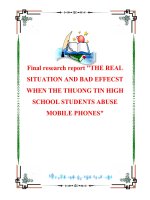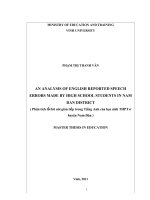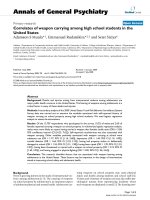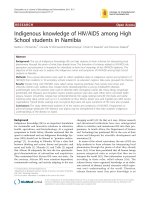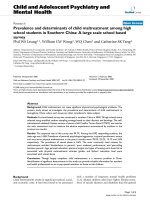The current depression situation of public high school students in Danang city
Bạn đang xem bản rút gọn của tài liệu. Xem và tải ngay bản đầy đủ của tài liệu tại đây (206.58 KB, 7 trang )
Journal of military pharmaco-medicine n02-2019
THE CURRENT DEPRESSION SITUATION OF PUBLIC HIGH
SCHOOL STUDENTS IN DANANG CITY
Nguyen Thi My Anh1; Tong Thi Luyen2; Truong Ngoc Tai1
Huynh Minh Giang1; Phan Thi Hoang Oanh1
SUMMARY
Objectives: To determine the prevalence of depression disturbances and factors related to
depression of 457 high school students in Danang City. Methods: Cross-sectional study and
using DASS 42 scale. Results: The incidence of depression among high school students in
Danang was 40.9%, including mild, moderate, severe and very severe levels (14.0%, 13.1%
and 13.8%, respectively). Friends and living conditions, family conflicts, isolation of friends,
study pressures, self-targeting, feelings of inferior to friends and using alcohol are all related to
depression (p < 0.05). Conclusion: The incidence of depression among students for factors as
family and school causes is alarming. There is a need to establish free mental health counseling
centers to support specialized psychological knowledge for teachers and parents.
* Keywords: Depression; Students; Public high school.
INTRODUCTION
Severe depressive disorder will lead to
some actions such as suicide, self-harm
and alcohol/drug abuse, ranking among
the top 10 causes of the current burden of
disease in today's world. It is estimated
that around 350 million people in various
age groups all over the world suffer from
depression [2]. In Asia-Pacific countries,
according to Chiu E (2004), the average
percentage of depression was 3.7%,
much lower than in other regions of the
world [10].
In Vietnam, the percentage of depression
among children has icreased and it has
affected their education and life. Therefore,
the authors did the research on “Depressive
disorders of students in public high schools
in Danang City” with two aims: To determine
evidence of depressive disorder among
students and find out factors related to
depression among students.
SUBJECTS AND METHODS
Subjects.
* Study subjects: Students in 7 public
high schools in Danang City.
* Selection criteria: Voluntarily agree to
participate. Attend class at the interview
time.
* Exclusion criteria: No co-operation.
Insufficient answers in the questionnaire,
been examined and diagnosed with
depression.
1. Univerrsity of Medicine Technology and Pharmacy
2. Danang Psychiatric Hospital
Corresponding author: Nguyen Thi My Anh ()
Date received: 20/12/2018
Date accepted: 18/01/2019
170
Journal of military pharmaco-medicine n02-2019
2. Methods.
- Use the descriptive cross-sectional
study method.
* Sample size design: The research
sample size was calculated according to
the formula.
* Sampling method: Four-stage cluster
sampling.
* Research tool: Use DASS 42.
* Time and place of study: From 10 2017 to 10 - 2018 in 7 public high schools
in Danang City.
* Data processing: Use EPIDATA software
to enter data and use SPSS 22.0.
p: Percentage of depression, according
to research by Le Minh Thuan [4], p = 0.24;
d: 0.04. Substitute into the formula, we
had 437 samples. Plusing 10% of the
sample was incorrect or not participation,
we got a sample size of 480. In fact, we
obtained 457 samples.
* Research ethics:
Students were given a clear explanation
of the purpose of the study, willing to
participate and guaranteed confidentiality
when participating in research. They would
refuse if they didn't not want to answer
the research questions.
RESULTS AND DISCUSSION
1. Incidence of depressive disorders and severity of depression.
59.1 %
40.9 %
No
Depression
Chart 1: Incidence of depressive disorders of public high school students.
The study showed that the percentage of students suffering from depression was
(40.9%) lower than the results of depression study by Do Bich Ngoc (60.8%),
Nguyen Thi Huong (49.5%), higher than the study by Do Dinh Quyen (39.6%),
Nguyen Truong Vien (29.2%), Tran Quynh Anh (38.9%) [1, 4, 5, 6, 8].
171
Journal of military pharmaco-medicine n02-2019
14
13.8
13.6
13.4
13.2
13
12.8
12.6
Severity of
depression
14%
13.8%
13.1%
Mild
Moderate
Severity
Chart 2: Specific depression rates of high school students.
Depression rates at specific levels of mild (14.0%), moderate (13.1%), severe
(13.8%) were lower than those of Le Minh Thuan‟s study with severity of 24% [7].
For the reasons, research objectives and areas are in Hochiminh City, Hanoi; life is
always busy, noisy, crowded, cramped, demanding economic conditions and with many
other agents which create depression easily rather than in Danang.
2. Some factors related to depression status.
* Demographic factors and depression:
Table 1: Relationship between demographic factors and depression.
Severity of depressive disorders
Total
Features
Object
No
p
Yes
n
%
n
%
n
%
Male
107
60.8
69
39.2
176
38.5
Female
163
58
118
42
281
61.5
Social
146
63.5
84
36.5
230
50.3
Science
106
57.3
79
42.7
185
40.5
Other
18
42.9
24
57.1
42
9.2
242
61.3
153
38.7
395
86.4
Countryside
29
46.8
33
53.2
62
13.6
Happy
223
59.8
150
40.2
373
81.6
Separated
26
70.3
11
29.7
37
8.1
Divorce
5
35.7
9
64.3
14
3.1
Other
16
48.5
17
51.5
33
7.2
Sex
Majors
> 0.05
Habitat
Parental
marriage
< 0.05
< 0.05
< 0.05
In the demographic factor, only the place of living is related to depression. The percentage
of students living in rural areas with depression was 53.2% compared to the city with
depression of 38.7%. In this factor, it is possible that the number of students from rural
172
Journal of military pharmaco-medicine n02-2019
areas to rent accommodation in the city should be unfamiliar with the pressure of life so
they are easy to get depression. It is needed to perform more studies on cultural
factors related to depression among students to clarify. Depression of male and
female, parental marriage was not related with depression of students, with p > 0.05.
* Family factors and depressive disorder:
Table 2: Relationship between family factors and depressive disorder.
Family factors with depressive disorders
No
Depression
Content
Yes
Total
p
n
%
n
%
n
%
No
184
65.5
97
34.5
281
61.5
Yes
87
49.4
89
50.6
176
38.5
No
76
58.5
54
41.5
130
28.4
Yes
195
59.6
132
40.4
327
71.6
No
259
61.8
160
38.2
419
91.7
Yes
12
31.6
26
68.4
38
8.3
No
206
58.2
148
41.8
354
77.5
Yes
65
63.1
38
36.9
103
22.5
Conflict with family
< 0.05
Parental expectations for
their children
> 0.05
Family in trouble
< 0.05
The relatives in family
were dead or sick
> 0.05
There is no relationship between depression and parental expectations for their
children and the death and sickness of relatives in family. There was a relationship
between depression and conflict with family and family in trouble with a 1.5-fold
difference when there was conflict leading to depression (50.6%) compared with no
conflicts and depression (34.5%), family in trouble has the depression rate (68.4%)
higher 1.8 times than family without trouble (38.2%). The study was consistent with
Tran Quynh Anh's survey on family conflict (49.5%), which was 1.3 times higher than
(37.0%) [2], Vo Van Ban 76.47%; Nguyen Thi Kim Cuc 28.9%; Nguyen Thanh Quang
19.23%. Family conflict is an important cause of depression for students because their
time in the family is mainly and their only support is family. However, for some reasons
leading to conflict will affect the psychology of the children, feel disoriented, not interested,
no support..., so students will be prone to depression.
* School - friend factors and depressive disorders:
Table 3: Relationship between school factors and depressive disorder.
Friends, learning factors and depressive disorders
No
Depression
Content
Yes
Total
p
n
%
n
%
n
%
No
240
60.2
159
39.8
399
87.3
Yes
31
53.4
27
46.6
58
12.7
Conflict in love
> 0.05
173
Journal of military pharmaco-medicine n02-2019
No
205
62.5
123
37.5
328
71.8
Yes
66
51.2
63
48.8
129
28.2
No
246
62
151
38
397
86.9
Yes
25
41.7
35
58.3
60
13.1
No
250
60.4
164
39.6
414
90.6
Yes
21
48.8
22
51.2
43
9.4
No
90
69.8
39
30.2
129
28.2
Yes
181
55.2
147
44.8
328
71.8
Conflict with friends
< 0.05
Isolated by friends
< 0.05
Bullied by fiends
> 0.05
Learning pressure
< 0.05
There was a relationship between present conflict with friends, isolated by friends,
learning pressures and depression expression (p < 0.05) (48.8% compared to no
conflicting 37.5%). In study by Tran Quynh Anh, the percentage of conflict with friends and
no conflict with friends was 54.3% vs. 35.0%, being isolated by friends 58.3% compared to
38.0%, learning pressure 44.8% compare to 30.2%, similar to Vo Van Ban‟s study with
very high learning pressure (58.82%), Nguyen Thi Kim Cuc 35.6%. Friendships are also
very important in their lives, they will suffer from psychological disorders such as suffering,
torment, sadness and loneliness if friendship is not respected plus high learning pressure
from parents, schools, especially high achievement school... there will be more pressure
and difficulty if teachers (with specialized field but no psychological counseling or lack of
moral psychological practice) will not grasp timely psychology of the students that will make
them more deeply hurt spirit
* Student personal factors and other factors:
Table 4: Relationship between personal factors and other factors with depression.
Student personal factors and other factors with depression
No
Depression
Content
Yes
Total
p
n
%
n
%
n
%
No
143
73
53
27
196
42.9
Yes
128
49
133
51
261
57.1
No
123
73.2
45
26.8
168
36.8
Yes
148
51.2
141
48.8
289
63.2
No
261
60.8
168
39.2
429
93.9
Yes
10
35.7
18
64.3
28
6.1
No
246
63.4
142
36.6
388
84.9
Yes
25
36.2
44
63.8
69
15.1
Setting too high goals
Feeling inferior to
friends
Sexual harassment
Previously suffered
from childhood traumas
174
< 0.001
Journal of military pharmaco-medicine n02-2019
The relationship between personal factors and other factors with depression; setting
too high goals was a high depression rate of 1.9 times than without setting goals
(50.0% compared to 27.0%), feeling inferior to friends was 1.8 times (48.8% and 26.8%),
high sexual harassment was 1.64 times (64.3% vs. 39.2%). This is also the cause of
depression, in life there are many factors that affect the change of human psychology if
the individual who does not think positive will be affected.
* Behavioral factors and depressive disorders:
Table 5: Relationship between stimulant use and depression.
Stimulant use factors with depressive disorders
No
Depression
Yes
Total
p
Content
n
%
n
%
n
%
No
262
60
175
40
437
95.6
Yes
9
45
11
55
20
4.4
No
257
60.8
166
39.2
423
92.6
Yes
14
41.2
20
58.8
34
7.4
Smoking habit
> 0.05
Alcohol consumption
< 0.05
Alcohol consumption behavior of students was related with students‟ depression
with p < 0.05. Meanwhile, smoking behavior was not related. Alcohol use was related
to depression (58.8%; 39.2%), it is similar to the study by Le Minh Thuan, a group of
students with alcohol use had a higher depression than those without alcohol 1.5 times.
Although this study did not quantify the amount of alcohol in each drink times, the results
showed that an interaction between behavior and depression rates among students.
* The demand for psychological counseling - health of students:
The chart showed that the demand for counseling on mental health was high at 79.2%.
175
Journal of military pharmaco-medicine n02-2019
CONCLUSIONS AND
RECOMMENDATIONS
1. Conclusions.
- The research showed that 40.9% of
students with depression. However, students
with depression: mild were 14.0%, moderate
13.1%, severe 13.8%.
- There are some factors related to
depression, including family factors such
as family conflict (50.6%), family in trouble
(68.4%). The school factors including
learning pressure (44.8%), isolated by
friends (58.3%), conflict with friends
(48.8%) and personal factors as setting
too high goals (50.0%), feeling inferior to
friends (48.8%). Alcohol consumption
behavior 58.8%.
2. Recommendations
Research may contribute to reduce the
percentage of mental disorder if the
model of psychological intervention for
students in high schools in Danang City is
implemented. The results showed that
students need a lot of activities with
psychologists, free health counseling centers,
family cares, and appropriate teaching
and learning methods to help them
overcome the difficulties in their studies,
their family and their emotional life.
seminar of Psychiatric medical psychology.
2017, pp.21-28.
3. Nguyen Thi Kim Cuc. Research on
clinical manifestation of depressive disorder
aged 19 to 29 inpatient at psychiatric hospital.
Vietnam - French Scientific seminar of Psychiatric
medical psychology. 2017, pp.121-124.
4. Nguyen Thi Huong et al. The current
situation of health behavior and risk of
depression among second year college students
in Commercial University. Clinical. 2014, 914,
No. 4.
5. Do Bich Ngoc. Depression disorder
among secondary school students in Hanoi.
Master Thesis of Science in Psychology from
Vietnam National University. Hanoi University of
Social Sciences and Humantities. 2017.
6. Do Dinh Quyen. Depression and among
the first year medical students in University of
Medicine and Pharmarcy Hochiminh City,
Vietnam. College of Public Health Sciences,
Chulalongkom University. 2007.
7. Le Minh Thuan. Research on the
situation of psychological diorders of college
students in Hochiminh Medical University.
Master Thesis of Psychology from Hochiminh
University of Education. 2012.
REFERENCES
8. Nguyen Truong Vien et al. The relationship
between internet addition and depression
among Nguyen Cong Tru secondary school
students in Bienhoa city, Dongnai. Hochiminh
Journal of Preventive Medicine. Basic Science.
2018, p.339.
1. Tran Quynh Anh. Signs of depression of
preventive medicine students at Hanoi
Medical University and some related factors.
Journal of Medicine. 2016, 104, p.6.
9. Amar M. Depression among adolescents.
Proceedings of the Vietnam-France Mental
Scientific Conference. Vietnam-France Hospital.
2007.
2. Vo Van Ban. Find out the factors related
to depression on the group of college students
studying abroad. Vietnam - French Scientific
10. Spaner D, Bland R.C, Newman S.C.
Depression Disorder, Research Center (N-T).
Vietnamese translation. 1994, pp.7-15.
176


